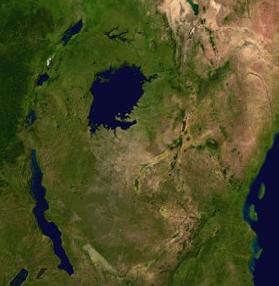African Great Lakes
2007 Schools Wikipedia Selection. Related subjects: African Geography

The Great Lakes of Africa are a series of lakes in and around the Great Rift Valley. They include Lake Victoria, the second largest fresh water lake in the world in terms of surface area, and Lake Tanganyika, the world's second largest in terms of volume as well as the second deepest. The Great Lakes are:
Some call only Lake Victoria, Lake Albert, and Lake Edward the Great Lakes as they are the only three that empty into the White Nile. Lake Tanganyika and Lake Kivu both empty into the Congo River system, while Lake Malawi is drained by the Shire River into the Zambezi.
Great Lakes region
Great Lakes also refers to the region around these lakes. These include the entirety of the nations of Rwanda, Burundi, and Uganda as well as portions of the Democratic Republic of the Congo, Tanzania, and Kenya.
It is one of the most densely populated areas of the world, with an estimated 107 million people living in the Great Lakes region. Because of past volcanic activity this part of Africa contains some of the world's best farmland. Its altitude also gives it a rather temperate climate despite being right on the equator. This has left it out of the disease zone allowing widespread use of livestock, especially cattle and goats.
Because of the density of population and the agricultural surplus in the region the area became highly organized into a number of small states. The most powerful of these monarchies were Rwanda, Burundi, Buganda, and Bunyoro. Unusually for sub-Saharan Africa, the traditional borders were largely maintained by the colonial powers.
Being the long sought after source of the Nile, the region had long been of interest to Europeans. The first Europeans to arrive in the region in any numbers were missionaries who had limited success in converting the locals, but did open the region to later colonization. The increased contact with the rest of the world led to a series of devastating epidemics affecting both humans and livestock. These decreased the region's population dramatically, by up to 60% in some areas. The region did not return to its precolonial population until the 1950s.
While seen as a region with great potential after independence, the region has in recent years been marred by civil war and immense violence, leaving the region in great poverty from which only Kenya and Tanzania are largely exempt.
